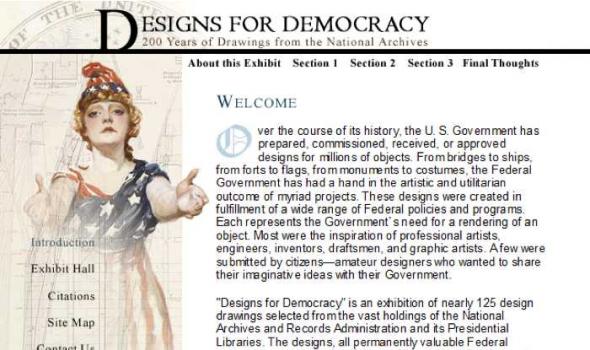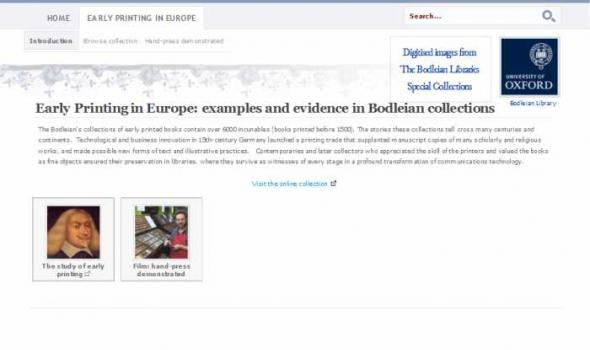Category: Arts & Humanities, Image, Maryland
Results
The National Archives and Records Administration Clifford K. Berryman: Political Cartoonist Extraordinaire In 1886 at the age of 17, Clifford K. Berryman moved from Kentucky to Washington, DC, to work at the U.S. Patent Office, where he used his self-taught talents to draw patent illustrations. He left the Patent Office in 1891 to become a cartoonist’s understudy for the Washington Post. Within five years, Berryman was chief cartoonist, a position he held until 1907 when he became the front-page cartoonist at the Washington Evening Star. Berryman drew political cartoons for the Star until his death in 1949 at the age of 80. Washington political circles embraced Berryman’s cartooning.
Guns, tanks, and bombs were the principal weapons of World War II, but there were other, more subtle forms of warfare as well. Words, posters, and films waged a constant battle for the hearts and minds of the American citizenry just as surely as military weapons engaged the enemy. Persuading the American public became a wartime industry, almost as important as the manufacturing of bullets and planes. The Government launched an aggressive propaganda campaign with clearly articulated goals and strategies to galvanize public support, and it recruited some of the nation's foremost intellectuals, artists, and filmmakers to wage the war on that front.
A note on the photographs in this exhibition Because of the huge number of images held by the National Archives and Records Administration (NARA), selecting photographs for this exhibition involved difficult and subjective choices. For the most part, the exhibit concentrates on developments within American society and on activities abroad where Americans were significant participants. The photographs from the White House Photo Office were included because they will become part of the Clinton Presidential Library, and because they allowed the exhibit to round out its coverage of the late 20th century.
Federal Designs: Symbolism Symbols are an important part of America`s design heritage. They establish and reinforce the national identity and patriotism. In some cases, American symbols are based on recognized associations. The ideals of Greek democracy, the power of Imperial Rome, or the refinements of European fashion frequently are reflected in Federal designs. At other times and for other purposes, designers created icons using images unique to this new country, to this new form of government, and to America`s aspirations to world power.
Dear Bess: Love Letters from the President "Dear Bess: Love Letters from the President" February 12, 1998 through September 1, 1999 Garden Room, Truman Library & Museum The Harry S. Truman Library and Museum is one of thirteen Presidential Libraries administered by the National Archives and Records Administration . 500 W. US Hwy. 24. Independence MO 64050 truman.library@nara.gov ; Phone: 816-268-8200 or 1-800-833-1225; Fax: 816-268-8295.
During the depths of the Great Depression of the 1930s and into the early years of World War II, the Federal government supported the arts in unprecedented ways. For 11 years, between 1933 and 1943, federal tax dollars employed artists, musicians, actors, writers, photographers, and dancers. Never before or since has our government so extensively sponsored the arts. MORE... This link is not functional because your browser does not support JavaScript or Javascript has been disabled. Please use this link to MORE...
From June through October 1973 and briefly during the spring of 1974, John H. White, a 28-year-old photographer with the Chicago Daily News , worked for the federal government photographing Chicago, especially the city`s African American community. White took his photographs for the Environmental Protection Agency`s (EPA) DOCUMERICA project.
Note that Albert Einstein is standing to the left of the President. This group shot was taken by Fred Scut of Washington, DC, one of the most prolific of panoramic photographers. The print size is 38" x 10". Records of the Office of the Secretary of Agriculture (16-ES-485) The description was handwritten on the photograph by Mr. Brooks. It was taken by Thompson Photo of Venice, CA, and measures 46" x 10". Records of the Bureau of Indian Affairs (75-PA-3-7) The photographer and date are unknown. The dimensions of the print are 54" x 10".
History of Medicine In 1816, an Englishwoman still in her teens, Mary Shelley, conceived the story of a scientist obsessed with creating life. Shelley's scientist, Victor Frankenstein, succeeds. But while Frankenstein's creature can think and feel, he is monstrous to the eye. Spurned by all, including Victor Frankenstein himself, the embittered creature turns into a savage killer. In 1818, Shelley's story was published as Frankenstein; or, The Modern Prometheus . This story — both in the original novel and shaped into new forms, such as plays, films, and comics — has captivated people ever since, exposing hidden, sometimes barely conscious fears of science and technology.
History of Medicine Home > History Home > Lesser Home This is my fourth exhibit over the last 20 years in a series presenting medicine and social healing in our century. When I reviewed my first book, from which the first exhibit was taken (auditing medical school at UCLA, with the Class of '71), and the second, about medical education in its entirety (from the student's first days until a physician's first professional experiences, in the '80's), I realized that another look was timely. I have always focused on the motivations of health care practitioners, as well as their human endeavors. I admire those who study and train to help others at this high level of knowledge and skill, which takes years to achieve and much personal sacrifice.
History of Medicine The National Library of Medicine (NLM) holds approximately 2,000 volumes of Chinese medical classics. Here we display a few of the earliest and most interesting texts from the NLM collection. Also included are portraits of a few significant figures in early Chinese medicine whose contributions range from acupuncture to the pioneering uses of herbal medicines to the concept of Yin and Yang. Through the exhibit, we hoped to draw attention to a fascinating part of NLM's historical resources. 23 October 2009
Medieval Islam Islamic cultures are among the most interesting, complex, and dynamic in the world. At the same time, they are among the least known in the West. From its dramatic rise in the seventh century A. D. to the present, Islamic civilization has covered a large part of the globe, incorporating many subcultures and languages into its orbit, and vigorously engaging the peoples around it. Medicine was a central part of medieval Islamic culture. Disease and health were of importance to rich and poor alike, as indeed they are in every civilization. Responding to circumstances of time and place, Islamic physicians and scholars developed a large and complex medical literature exploring and synthesizing the theory and practice of medicine.
Display of Goya Prints Featured at the NLM Thirteen prints by Francisco Goya (1746-1828) , a Spanish painter who stands among the first modern artists, are on display at the National Library of Medicine. Although Goya held a position as court painter to Spain's King Charles IV, he often mocked the powerful in his paintings and satirized Spain's government and church. His depictions of hospital patients, torture chambers, the poor, and people in complex psychological states, transformed the unmentionable into fit subjects for art. Two of the works are first editions created by Goya, while the others are "restrikes" printed by others using Goya's original plates.
History of Medicine Harry Potter's World: Renaissance Science, Magic, and Medicine I n 1997, British author J. K. Rowling introduced the world to Harry Potter and a literary phenomenon was born. Millions of readers have followed Harry to the Hogwarts School of Witchcraft and Wizardry where he discovers his heritage, encounters new plants and animals, and perfects his magical abilities. Although a fantasy story, the magic in the Harry Potter books is partially based on Renaissance traditions that played an important role in the development of Western science, including alchemy, astrology, and natural philosophy.
History of Medicine Robert Hooke (1635-1703) was a remarkably versatile man — artist, biologist, physicist, engineer, architect, inventor, and more. However, his crowning glory was Micrographia: or Some Physiological Descriptions of Minute Bodies made by Magnifying Glasses , first published 1665. It was a masterpiece — an exquisitely illustrated introduction to the previously unknown microscopic world. This exhibit focuses on Hooke's influences and legacy in print, the pioneering books that stimulated Hooke's research, and the works he left for others — most famously the great Dutch microscopist, Antoni van Leeuwenhœk (1632-1723). August 1 – November 1, 2007.
History of Medicine Español - Italiano Healing and faith have always played a role in the lives of the faithful. They are interwoven in the fabric of social history. How we regard illness and healing, and how we cope with them have captured our imagination throughout the ages. The expression of our relationship with illness is wonderfully illustrated in the ex-voto, a devotional painting giving thanks to a saint or deity for a miraculous healing or a blessing. The faithful have always used prayer to invoke the aid of saints as a means to heal the sick and end one's suffering. These devotional paintings are an individual's expression of thanks for the intercession of the divine in a crisis, a snapshot in time of illness and healing.
History of Medicine Introduction The National Library of Medicine's Bathtub Collection is an archive of materials found in the old bindings when rare books in the Library were conserved. The materials found in the bindings include fragments of old printed books or manuscript materials which are often treasures on their own. In the Bathtub Collection, NLM has organized and described these fragments and made them available to scholars. The story of the Bathtub Collection begins in the middle of the last century. In the 1940's, The Army Medical Library, as the National Library of Medicine was then known, began a serious conservation program for its rare book collection. The AML hired Dorothy Schullian as curator of rare books and Jean Eschman, a master bookbinder from Switzerland.
History of Medicine The Letters | Life, Family, and Times | Henkel Family Heritage | Colophon , , , , U.S. National Library of Medicine, 8600 Rockville Pike, Bethesda, MD 20894 , Last reviewed: 26 July 2011 Last updated: 26 July 2011 First published: 14 June 2010 | : Permanent: Dynamic Content
Medicine in the Old World arose from many components: the classical Greek tradition, its Christian re-elaboration, the contributions of the Arabic World, and the unique medieval synthesis of them all. By examining significant pages and illuminations from manuscripts and early printed books of the National Library of Medicine, one can see how these cultures contributed to the creation of medical knowledge in Europe.
These pages are a journey through time and space, as medical knowledge moved around and across the Mediterranean Sea. Mare nostrum—Our Sea—divided societies into several groups, but it could be crossed, making cultural contact, trade, and the exchange of ideas possible.





































